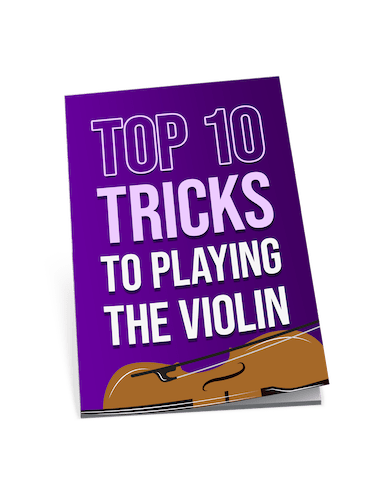Holding the violin bow properly is key to making magic with those strings. It can significantly improve how you play and make your whole experience much more enjoyable.
It will also help you hold the bow comfortably for longer periods of time without fatigue.
We’ve created this guide to help you discover how to hold the violin bow step-by-step.
We will discuss the right way of holding a violin bow, why we hold it that way, and common mistakes beginner violinists make with their bow hold.
But before getting into that, let’s start with the basics of how to hold a violin bow.
How do you hold a violin bow?
You can make it as complicated or as simple as you want. But really, it’s just six steps:
Step One: The Bunny
Step Two: Thumb Placement
Step Three: Your Index Finger
Step Four: Your Middle Finger
Step Five: Your Ring Finger
Step Six: Your Pinky Finger
Why do we hold the violin bow in this way?
A proper and natural bow hold is essential to producing a good sound. A correct bow hold is key to optimizing the bow’s vibrations and producing the best sound possible.
Plus, it’ll stop your arm and hand from aching when you play for a few hours a day!

How to Strengthen Your Bow Hand
You can start with simple exercises like holding a pencil or pen at the tip of your pinky finger in your bow hand. Doing so will help you develop finger stability and your finger muscles. There are also three great exercises to help
How to Strengthen Your Bow Hand
Finger push-ups: Place your fingers on a flat surface and push down, lifting each finger off the surface one at a time. This exercise can help strengthen your fingers and improve your grip on the bow.
Bow grip exercises: Practice holding the bow in different ways, such as with just your thumb and pinky or with your fingers in a different position. This can help improve your control over the bow and strengthen your hand muscles.
Resistance band exercises: Use a resistance band to strengthen your bow arm and hand muscles. Wrap the resistance band around your hand and fingers and stretch it out, holding for a few seconds before releasing.

Common Mistakes with a Beginner Violin Bow Hold
Poor wrist-hand-arm alignment is a common mistake with bow holds. It can lead to soreness and/or injury if not corrected.
Keeping the palm and wrist stiff while practicing can cause soreness after long hours of violin playing. This is because the fingers and hand are repeatedly flexed and extended similarly, causing strain on the arms, wrists, and hands. If you practice the violin for long hours, try experimenting with different finger positions, hand positions, and bow hold styles to find what works best for you. If you feel unnatural, something is probably wrong.
Over-extending the bow arm can result in chronic physical issues such as strains and sprains. Also known as the “bowist’s arm,” this tip of the bow arm should be drawn back slowly to avoid sudden movements that could potentially cause injury.

The direction of the bow
The bow should be tilted slightly towards the fingerboard. The bow should be drawn in a straight line parallel to the bridge.
Place the bow in the middle point between the bridge and the fingerboard for most playing.
Scratchy noises and bow hair
To avoid scratches on the violin strings, ensure the bow hair is parallel to the bow stick when playing. You may also need to use the end screw to loosen or tighten the hair of the bow, or add more rosin to the bow.
The rosin we recommend is D’addario Kaplan:
D'Addario Kaplan

DESIGNED FOR: Violin & Viola
FEATURES: Premium case that is designed for one-handed use
OTHER INFO: The original low-dust recipe handed down from Ladislav
D'Addario Kaplan
- Amazing Case
- Low Dust
- A Pleasure To Use
- None!
When you click ‘Check Price’, you’ll see there are loads of great places to buy this item. Our personal favorite is Sweetwater for the US, and Thomann and Gear4Music for the UK & Europe.
They are the largest music retailers, with excellent customer service, competitive prices, really fast shipping, and the longest guarantees.
The professional musician who wrote this article combined many things,
from the product build, manufacturer’s reputation through to feedback
from other users, to create our famous TedScore™.
Maintaining the Correct Violin Bow Hold
Maintaining the correct bow hold can be tricky. Like any technique, you never ‘arrive’ at your destination; it’s all about improving little things constantly and being aware if bad habits start to form.
It doesn’t matter if you practice the Franco Belgian Violin Bow Hold that we discuss in this article or if you are learning another method like the Russian Violin Bow Hold; it’s all about consistency.
Don't bend the wrist
The key to playing the violin is to relax and hold the bow with ease. Keep your pinky curved, keep the thumb bent and relax your wrist as much as possible. The more weight and tension you add to your bowing, the more your wrist will ache.
Lastly, it may feel natural, but don’t keep your elbows high or shoulders tense; this can lead to fatigue and injuries really easily.
If you’re looking to buy your first violin, make sure you read our Violin Buyer’s Guide here.
How to hold a violin bow
Summary
Here are some key things to remember:
The left-hand side of the violin should be slightly tilted towards the index finger for more control
Hold the bow at an angle of about 45 degrees to the fingerboard. This will allow you to reach all of the instrument’s notes easily
Try and keep the level of the arm and bow constant while playing on different strings
Make sure you form those bunny ears well(!)
Get your fingers relaxed; your thumb needs to stay curved
Practice long bow strokes to remove tension – and don’t put too much pressure on the string
If you can hold the violin bow correctly, you’ll play it better; it’s as simple as that! Getting (and maintaining) the perfect violin bow hold is the first step of playing the violin.
It may seem difficult initially, but practising will make it feel natural in no time.
Comment below to let us know if these tips were helpful!
FAQ's
If you want to hold your violin bow stick the proper way, you’ll need to do the “bunny bow hold” or the Russian bow hold. This good bow hold consists of curving your index finger and pinky finger up to make the ears of the bunny. With your thumb, create the chin of the bunny, while your middle fingers make the nose. The bow is the same shape as a carrot in the middle of the bunny’s hand! Having a great teacher and violin lessons will help.
Teaching a beginner how to properly hold the bow is an integral part of the violin-learning process for beginners. The most common bow hold is the Franco-Belgian Bow Hold, which requires the bow hand to hold the frog of the bow and the index finger extended across the bow stick. Some people think this is the ‘perfect bow hold’. Be sure to have the proper bow grip and no tension (especially in the forearm), or they can quickly form bad habits.
When you hold the bow of a violin, the right place to put your thumb is right onto the balance point of the bare section of the violin’s bow, positioned between the leather grip of the bow and the frog. Ensure that the tip of your thumb is always held against this middle section and not against any other part of your hand and that it has a curve. These great habits and a proper technique will help any beginner violinist improve your violin playing and avoid injury.











It’s interesting to consider the physical relationship between musician and instrument. The way we hold the bow is almost a dialogue, a close interaction that many might overlook.
Traditional methods have existed for so long for a reason, they provide a strong foundation!
Does the type of violin bow make a difference in how you hold it? I’m pretty new to this and was wondering if a specific bow is easier to handle?
As a viola player, I find the technique for holding a bow quite similar yet subtly different due to the weight and balance. It’s fascinating to compare the nuances between the violin and viola.
Great step-by-step guide for beginners. Maintaining the correct hold is crucial for effective learning and avoiding bad habits. Every student struggles at first, but persistence pays off.
Sure, like I’m gonna be the next Mozart because I held my bow right. Dream on.
finally, i can send this to my neighbor and maybe, just maybe, my ears will get some peace. here’s hoping lol
Interesting article. I’ve seen plenty of techniques but it’s good to know the basics.
If only Beethoven had this guide, maybe his symphonies would have fewer scratchy noises. Just kidding, love the article!
people still believe you can learn violin from an article? good luck with that. nothing beats a real teacher.